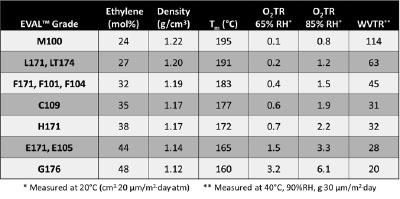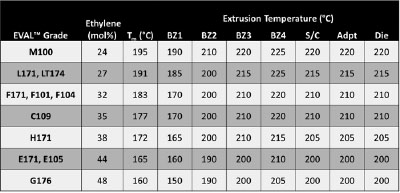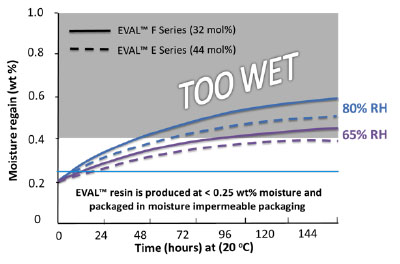Barrier Resins | Properties, Processing & Handling of EVOH, Pt. 1
- Published: February 02, 2015, By Gene Medlock
 Ethylene Vinyl Alcohol copolymer (EVOH), a semi crystalline random copolymer of ethylene and vinyl alcohol, is widely and most commonly used in packaging structures for perishable food because of its superior barrier to oxygen. The high barrier performance of EVOH, even after abuse, has allowed for conversion from foil and metallized film laminations to co-extruded barrier films.
Ethylene Vinyl Alcohol copolymer (EVOH), a semi crystalline random copolymer of ethylene and vinyl alcohol, is widely and most commonly used in packaging structures for perishable food because of its superior barrier to oxygen. The high barrier performance of EVOH, even after abuse, has allowed for conversion from foil and metallized film laminations to co-extruded barrier films.
EVOH can easily be co-extruded with all types of polyolefins, polyamides and other materials using standard extrusion equipment. EVOH is a hydrophilic material, so EVOH resin must be dry prior to extrusion processing. EVOH resins have poor adhesion to most polymers, so functionalized adhesive resins, commonly called tie resins, are used to bond the EVOH layer to other polymer layers in packaging structures.
EVOH resins exhibit good thermal stability when used in properly designed extrusion systems with appropriate processing conditions. The scrap generated in polyolefin/EVOH coextrusion is commonly recycled as a regrind layer in sheet and bottle applications. Coextruded packages with EVOH can also be recycled post-consumer.
EVOH Resin Properties and Applications
EVOH is best characterized as a random copolymer of ethylene and vinyl alcohol and grades are identified by the mol% of ethylene content. EVOH was developed as a derivative of PVOH with ethylene as modifier mol% ethylene was established as an index for the modification level. The mol% ethylene influences the balance of gas barrier and formability/orientability among other properties. EVOH is most well-known and most commonly used for its gas barrier properties, particularly as an O2 barrier in food packaging. The oxygen barrier of EVOH is orders of magnitude higher than commonly used polyolefin resins and even medium barrier polymers like polyamide (PA) and polyethylene terephthalate (PET). EVOH also has superior barrier properties compared to other high barrier materials such as polyvinylidene chloride (PVDC), under most conditions.
The lower the EVOH mol% ethylene is, the higher the gas barrier properties, density, and melting point temperature, and the higher the EVOH mol% is, the greater the flexibility and ease of processing among other properties. Commercial grades of EVAL EVOH range 24 mol% to 48 mol% ethylene. Table I contains basic properties of EVAL EVOH grades, including mol% ethylene, density, melting point, oxygen transmission rates, and water vapor transmission rates.

EVOH is very versatile, making it one of the dominant barrier materials for a broad range of applications, not only in food applications, but in non-food applications as well. In addition to providing excellent oxygen barrier for food packaging, EVOH is capable of meeting other demanding requirements, such as oxygen barrier in medical packaging, flavor preservation in coffee, and barrier to fragrances and solvents in cosmetics packaging. For example, EVAL 27 mol% (L type) is used for very high barrier in flexible food packaging applications.
EVOH Processing
EVOH resins can be easily processed on conventional plastic extrusion and other fabrication equipment and do not require special modifications like that for polyvinylidene chloride or polyvinyl chloride. EVOH resins exhibit rheological properties similar to other resins and can be coextruded with many types of polyolefins, nylons, polystyrene, polyvinyl chloride, polyesters, and thermoplastic polyurethanes.
EVOH resins have very poor adhesion to most of the aforementioned polymers, so modified polyolefin adhesive resins, commonly called “tie resins,” are used to bond the EVOH layer to the adjacent layer in coextrusion. Some nylons and thermoplastic polyurethanes will adhere directly to EVOH without the use of tie resin. EVOH resins can be processed on commercially available equipment in the following processes:
- Coextrusion coating for film and paper
- Coextrusion film laminating
- Coinjection stretch blow molding
- Coextrusion blow molding
- Monolayer blown and cast film extrusion
- Monoinjection and coinjection molding of containers, fitments, and other parts
- Multilayer blown and cast film extrusion
- Powder coating
- Profile coextrusion Sheet coextrusion
In addition to primary extrusion processing, EVOH film and sheet can be modified in secondary processing such as co-orientation film (tenter frame), sheet thermoforming, and double or triple bubble blown film. The processes are used to produce formed rigid barrier containers and a range of flexible barrier bags, films, and pouches, and other containers and packaging.
Similar to other extrusion polymers, EVOH resins can be degraded by prolonged exposure to thermal energy, both drying and extrusion processing. Proper extrusion conditions and optimal extrusion equipment design should be used to prevent degradation.
EVOH resins are easily processed on conventional extruders without special modification. Both single stage metering screws and barrier screws are used for EVOH processing, but barrier screws are the most popular type of screw for processing EVOH resin due to their higher output. EVOH has a high affinity to metal, so screws, adapter pipes, feed blocks, and dies for processing EVOH should be chrome or electro-less nickel plated to help prevent the accumulation of degraded polymer on the screw. Screws with mixing heads can be used for extruding EVOH resin, but this is generally not recommended because mixing heads can restrict flow and result in degradation of the EVOH melt. Static mixers are not recommended.
The residence time and temperature in EVOH extrusion system should be minimized to prevent polymer discoloration, gels, fish eyes, and significant changes in melt viscosity. Minimizing residence time can be accomplished by using properly sized EVOH extruders, avoiding low extruder speed, using adapter pipes with minimal length and smaller bore diameters and eliminating dead spots in the extrusion system.
EVOH processing temperatures should be set as low as possible without creating interfacial instability with adjacent layers and without getting unmelts or poor mixing. Also, processing EVOH over 240 deg C (465 deg F) is not recommended. Table II contains recommended extrusion temperature for EVOH. Additionally, extended downtime with EVOH in the extrusion system should be avoided, and EVOH should be thoroughly purged out of the system prior to shut down. The EVOH extruder speed should be set to no less than 10 rpm.

EVOH Regrind
One economic concern in coextrusion is the loss of in-process trim scrap or flash. In-process multilayer EVOH scrap can be recovered and reused. Post-consumer recycle of EVOH containing packages is also possible.
Regrind containing up to 15% EVOH is commonly used as a discreet layer in multilayer sheet structures for rigid thermoformed containers. EVOH regrind can also be used at less than 5% in discreet layers in thin film structures, but the optical properties and mechanical properties may be negatively impacted.
Prolonged exposure of EVOH regind to the ambient environment will result in high moisture absorption of the EVOH in the regrind, so the regrind must be dried prior to extrusion.
EVOH Moisture Absorption and Drying
EVOH resins are inherently hydrophilic, so precautions should be taken to prevent moisture absorption (see Figure 1). EVAL resins are produced with less than 0.25 wt% moisture and are shipped in foil-based moisture impermeable bags or carton liners to prevent moisture absorption. Moisture in EVOH resin may cause processing difficulties, such as foaming or voids in the extrudate. Precautions should be taken after opening a container to prevent excessive moisture absorption, especially in hot, humid environments. These precautions include:
- Keeping the EVOH container away from water sources and wet areas
- Cutting only a small access hole in the liner or bag and insert the vacuum wand
- Resealing the bag or liner after use
- Using a moisture trap if an air conveying system is utilized
EVOH may be exposed to the ambient environment for periods up to 24 hours while the resin is being consumed, unless processing in a hot, humid environment.

If the moisture content of EVOH resin exceeds 0.4%, it should be dried in a desiccant type circulating air dryer at a temperature of 195 deg to 230 deg F (90 deg to 110 deg C) for up to four hours, depending on the moisture level. Caution should be taken against over drying EVOH resins because moisture content below 0.05% may cause the EVOH resin to thermally degrade. Over drying can also cause an increase in viscosity, making processing more difficult.
ABOUT THE AUTHOR
Gene Medlock is technical service and development manager for the EVAL Division of Kuraray America Co., a leader in specialty chemical, fiber, and resin production. The company has top-of-the-line research and production facilities located in Houston, TX, and a network of supply from around the world. Prior to joining Kuraray, he was process engineer at Kaneka High Tech Materials. Gene holds a US patent in polymer carpet backing, and he earned a BS in chemical engineering from Texas A&M University.
Part 2 of this article will be published next month.












